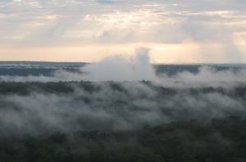Study on rainforest atmosphere raises new questions
Our atmosphere has an efficient means of self-purification performed by hydroxyl radicals (OH). These radicals oxidize hydrocarbons such as the greenhouse gas methane and toxic exhaust gases from traffic and industrial activity, so that these can be washed out by rain. This purification process takes place mainly in the tropics. Up until recently, it was presumed that the volatile organic compound isoprene made up the largest proportion of the reactants for OH. However, a current study by the Max Planck Institute (MPI) for Chemistry, published in the magazine "Nature Communications" at the end of January, is now showing that, primarily in the dry season, isoprene is only responsible for roughly 20 percent of the OH reaction rate in the tropical Amazon rain forest. The compounds accounting for the remaining critical 80 percent have yet to be discovered.

"Previously, it had been assumed that isoprene was the main OH radical reactant in the rainforest. Our comparative reactivity measurements reveal the presence of undiscovered OH reactants which our measurement devices for single compounds could not detect," concludes Jonathan Williams. "What we have discovered can easily be compared to the dark matter in astronomy. We know it does exist, but we can't explain what it is or where it comes from. Similarly, we found out that significant quantities of unknown trace gases are present in tropical air which have not yet been identified. However it is clear to us that they must exist," he adds.
Jürgen Kesselmeier was also astonished by the new findings: "There are always surprises in store for us when working in natural conditions in an ecosystem such as the Amazon rain forest. The sheer number of already known volatile compounds emitted into the atmosphere by trees is breath-taking high. Now, we have an idea of the task ahead." Last year, the construction of the ATTO climate measurement tower in the Amazon rain forest was finally concluded with the support of the Max Planck Institute (MPI) for Biogeochemistry in Jena. The researchers hope to be able to answer the questions raised by their current study while doing further measurements at the lofty heights of the ATTO tower. "At 300 meters, you immerse in exactly that zone in which atmosphere's cleaning processes take place." There we will be right in the middle of the rain forest to hopefully uncover these unknown chemicals," says Jonathan Williams, looking into the future.
"With this study from the heart of the Amazon rainforest, we are getting an invaluable insight into the cycle of hydroxyl radical (•OH) - a chemical species that has, amongst many others, a significant role in removing greenhouse gases from the atmosphere through oxidation. “ explains Jost Lavric from MPI for Biogeochemistry and adds “I am very excited to see what more we can learn from future long-term observations at the Amazon Tall Tower Observatory about the climate system's behavior under changing conditions.
Background information:
There are two reasons which, so far, have led to the conclusion that isoprene is the main OH radical reactant: First, the volatile organic compound possesses a very high reactivity. Secondly, isoprene accounts for a large part of known emissions throughout the world - approximately half of all biogenic emissions are attributed to isoprene. Global isoprene emissions are roughly three times as high as all anthropogenic emissions put together.
